
The Yakovlev Yak-40 is a regional jet designed by Yakovlev. The trijet's maiden flight was in 1966, and it was in production from 1967 to 1981. Introduced in September 1968, the Yak-40 has been exported since 1970.

The Fiat G.91 is an Italian jet fighter aircraft designed and built by Fiat Aviazione, which later merged into Aeritalia. The G.91 has its origins in the NATO-organised NBMR-1 competition in 1953, which sought a light fighter-bomber to be adopted as standard equipment across the air forces of the various NATO nations. After reviewing multiple submissions, the G.91 was picked as the winning design of the NBMR-1 competition.

The Fiat 500, commonly known as "Topolino", is an Italian city car produced and manufactured by Fiat from 1936 to 1955.
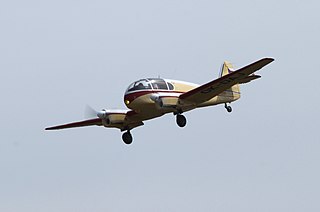
The Aero 45 was a twin-piston engined civil utility aircraft produced in Czechoslovakia after World War II. Aero Vodochody produced the aircraft in 1947–1951, after which the Let Kunovice rolled out these planes until 1961. In 1958 the Ae-45S became the first Czechoslovak plane to cross the Atlantic Ocean. It was the first product of the nation's postwar aviation industry and proved a great success, with many of the 590 produced being exported.

The Ilyushin Il-14 was a Soviet twin-engine commercial and military personnel and cargo transport aircraft that first flew in 1950, and entered service in 1954. The Il-14 was also manufactured in East Germany by VEB Flugzeugwerke as the VEB 14 and in Czechoslovakia as the Avia 14. The Ilyushin Il-14 was typically replaced by the Antonov An-24 and Yakovlev Yak-40.
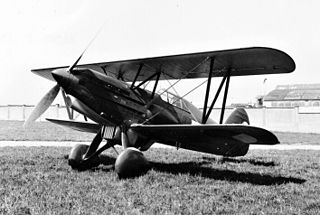
The Avia B-534 is a Czechoslovak biplane developed and manufactured by aviation company Avia. It was produced during the period between the First World War and the Second World War. The B-534 was perhaps one of the most well-known Czechoslovakian aircraft of the era.

The Arado Ar 96 is a German single-engine, low-wing monoplane of all-metal construction, produced by Arado Flugzeugwerke. It was the Luftwaffe's standard advanced trainer during World War II.

The Avia BH-5 was a two-seat sport aircraft built in Czechoslovakia in 1923. It was based on the firm's experience with the BH-1 and shared that aircraft's basic design: a low-wing, braced monoplane. As a result of its L-BOSA registration, all slow flying Avia monoplanes of the BH-5 lineage were nicknamed Boska. The BH-5 was flown competitively by Zdeněk Lhota at the Belgian Touring Aircraft Contest in Brussels in 1923, and won both the overall prize for the event and the King of Belgium Prize. The same year, it won the first prize in its class in the Czechoslovak President of the Republic Competition.
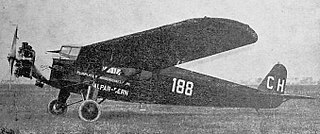
The Fokker F.IX was an airliner developed in the Netherlands in the late 1920s, intended to provide KLM with an aircraft suitable for regular services to the Dutch East Indies. When the onset of the Great Depression forced the postponement of those plans, the market for this aircraft disappeared as well, although it did see military service in Czechoslovakia as a bomber.
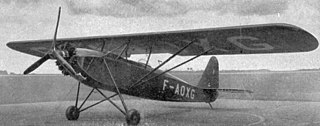
The Salmson Cricri ("Cricket") was a French light aircraft of the 1930s.

The Salmson Phrygane ("Caddisfly") was a French light aircraft of the 1930s.
The Fiat Model 7002 was a 1960s Italian general-purpose helicopter with a tip jet driven rotor built by Fiat Aviazione. Only one aircraft was built.

The AVIA FL.3 was an Italian two-seat cabin monoplane designed and built by Azionaria Vercellese Industrie Aeronautiche (AVIA) who were later taken over by Lombardi in 1947.
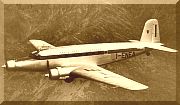
The Fiat G.212 was an Italian three-engine airliner of the 1940s. An enlarged development of Fiat's earlier G.12 transport, it was used in small numbers in commercial service and by the Italian Air Force.

The Fiat AS.1 was a light touring aircraft developed in Italy in the late 1920s.

The Fiat G.18 was an Italian airliner developed in the mid-1930s.

The Ambrosini Rondone is an Italian-designed two/three-seat light touring monoplane of the early 1950s.
TenenteCarlo Francesco Lombardi known as Francis was a World War I flying ace credited with eight aerial victories. Postwar, he was active in his family's rice refinery, as well as in record breaking flights. He formed the AVIA aviation company in 1938.
The SNCAC NC.860 was a French twin-engined development of the NC.853 light aircraft.
















